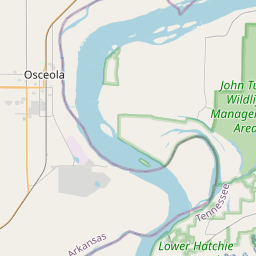Mississippi River Levee
Historical marker location:
Osceola, Arkansas
( Marker is on State Highway 198 when traveling east.)







© OpenStreetMap contributors
Loading...
Searching for other points of interest within 3 miles of this location.Arkansas has a rich Native American history, with numerous tribes including the Caddo, Osage, and Quapaw living in the region for thousands of years before European settlement. The Trail of Tears, which was the forced relocation of Native American tribes from the southeastern United States to Oklahoma, also passed through Arkansas.
About Mississippi County
Mississippi County Timeline
Mississippi County, Arkansas has a rich history that spans back to the early 19th century. The area was initially inhabited by Native American tribes, including the Chickasaw and Quapaw. European settlers began to arrive in the region in the early 1800s, with the Treaty of Dancing Rabbit Creek in 1830 leading to the forced removal of many Native American inhabitants.
The creation of Mississippi County, named after the Mississippi River, dates back to November 1, 1833. It was one of the original five counties established when Arkansas became a state. The county seat was initially located in Jefferson, but it was later moved to Osceola in 1837. The region developed into a prosperous agricultural area with the growth of cotton, which played a significant role in the county's economy.
The Civil War had a profound impact on Mississippi County, and it saw its fair share of battles and military actions. In 1861, Union troops set up a camp in Osceola, and tensions between the Confederate and Union forces persisted throughout the war. After the war, the county faced significant challenges in rebuilding its economy and infrastructure.
In the late 19th and early 20th centuries, the county witnessed growth and development with the expansion of transportation infrastructure, such as railroads and the construction of levees. Agriculture remained a vital industry, with cotton being the primary crop, although the county also saw the cultivation of other crops like soybeans and rice. Over time, industrial and manufacturing sectors also emerged, diversifying the county's economy.
Today, Mississippi County continues to thrive, with a mix of agricultural, industrial, and commercial sectors. It is known for its rich history, natural beauty, and diverse cultural heritage, making it an attractive place for visitors and residents alike.
The creation of Mississippi County, named after the Mississippi River, dates back to November 1, 1833. It was one of the original five counties established when Arkansas became a state. The county seat was initially located in Jefferson, but it was later moved to Osceola in 1837. The region developed into a prosperous agricultural area with the growth of cotton, which played a significant role in the county's economy.
The Civil War had a profound impact on Mississippi County, and it saw its fair share of battles and military actions. In 1861, Union troops set up a camp in Osceola, and tensions between the Confederate and Union forces persisted throughout the war. After the war, the county faced significant challenges in rebuilding its economy and infrastructure.
In the late 19th and early 20th centuries, the county witnessed growth and development with the expansion of transportation infrastructure, such as railroads and the construction of levees. Agriculture remained a vital industry, with cotton being the primary crop, although the county also saw the cultivation of other crops like soybeans and rice. Over time, industrial and manufacturing sectors also emerged, diversifying the county's economy.
Today, Mississippi County continues to thrive, with a mix of agricultural, industrial, and commercial sectors. It is known for its rich history, natural beauty, and diverse cultural heritage, making it an attractive place for visitors and residents alike.
Mississippi County Timeline
This timeline provides a concise overview of the key events in the history of Mississippi County, Arkansas.
- 1815 - Mississippi County, Arkansas, is established as part of the Missouri Territory.
- 1821 - Mississippi County becomes part of the Arkansas Territory when it is separated from Missouri.
- 1833 - Osceola is established as the county seat
- 1861-1865 - The Civil War impacts Mississippi County, with battles and skirmishes taking place.
- 1882 - The railroad reaches Mississippi County, leading to increased economic growth.
- 1927 - The Great Mississippi Flood devastates the county, causing widespread destruction.
- 1934 - The Dyess Colony, a farming community, is established by the federal government as a relief program during the Great Depression.
- 1944 - The Blytheville Air Force Base is established, providing a significant military presence in the county.
- 1962 - The Interstate 55 is completed, improving transportation and connecting Mississippi County to major cities.
- 2000 - The county experiences significant population decline and economic challenges.